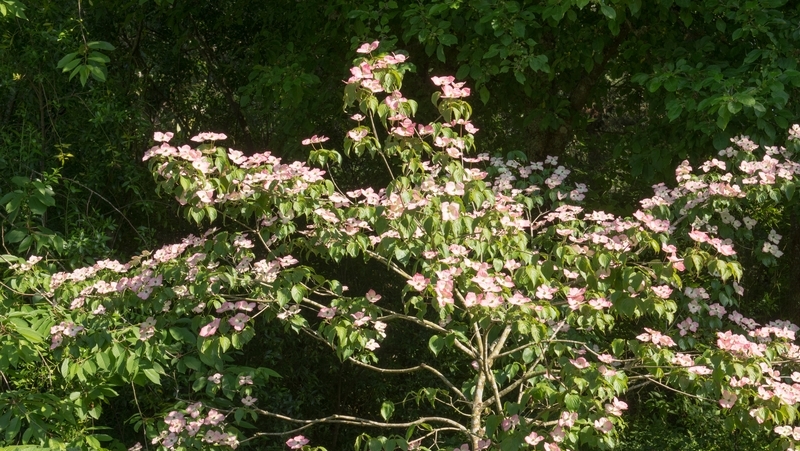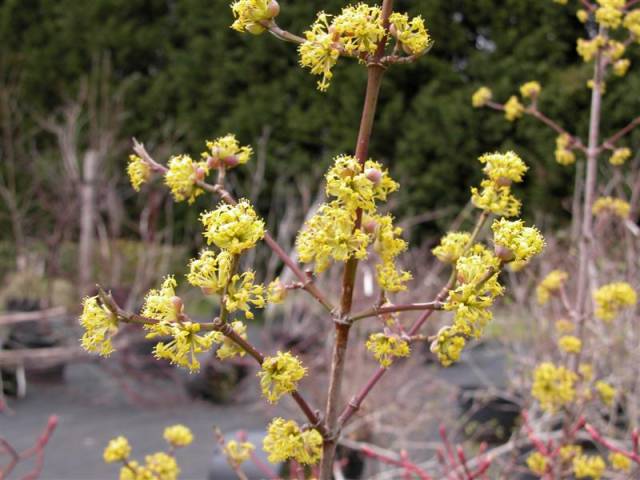
Common name refers to the cherry-like fruits which resemble in color the semi-precious gemstone carnelian (or cornelian). This name was applied to this plant because it was seen as the opposite of Cornus sanguinea, known as the female or wild cornel. The specific epithet mas means "masculine" or "male". Cornus is also the Latin name for cornelian cherry. Genus name comes from the Latin word cornu meaning horn in probable reference to the strength and density of the wood. Fruits may be used for making syrups and preserves. Fruits are edible, although sour tasting fresh off the plant. Fruits are ellipsoid, fleshy, one-seeded berries (drupes to 5/8" long) which mature to cherry red in mid-summer. Ovate to elliptic dark green leaves (to 4" long) typically develop insignificant fall color. Each umbel is surrounded at the base by small, yellowish, petaloid bracts which are much less showy than the large decorative bracts found on some other species of dogwood such as Cornus florida (flowering dogwood) and Cornus kousa (kousa dogwood). Yellow flowers on short stalks bloom in early spring before the leaves emerge in dense, showy, rounded clusters (umbels to 3/4" wide). Scaly, exfoliating bark develops on mature trunks. It typically grows over time to 15-25' tall with a spread to 12-20' wide. If you want to create a hedge, calculate around 2.5 plants per running metre, which corresponds to a planting distance of 40 cm. The tree can be pruned and trained into a single stemmed tree if desired and is primarily insect and disease resistant with the exception of dogwood anthracnose.Cornus mas, commonly known as cornelian cherry, is a deciduous shrub or small tree that is native to central and southern Europe into western Asia.

This adaptable plant is winter hardy to -25 to -30 degrees F.
#Pruning cornus mas full#
The trees do best in full sun to part shade and while they do well in a variety of soils, they prefer fertile, well-draining soil with a pH of 5.5-7.5. More often, the trees are seen as ornamental specimens, popular and planted around the 1920s.Ĭornelian cherry cultivation is suited to USDA zones 4 through 8. While historically significant, cornelian cherries have not been mass produced due to the elongated pit inside the fruit that is difficult to remove, as it is firmly entrenched in the pulp. Russians even make it into a cornelian cherry wine or add it to vodka. There is actually a myriad of other uses for cornelian cherries such as for syrups, jellies, jams, pies, and other baked goods. In fact, the ancient Greeks pickled the fruit much like olives. The ensuing fruit is initially very tart and looks much like olives. Although the plant is known primarily as an ornamental in the United States, ancient Greeks have been growing cornelian cherries for 7,000 years! Bright green glossy leaves turn purplish red in the fall. The bark of the tree is flaky, grayish brown to brown. Its not a very large shrub, growing to about 3m, so keep pruning to a. They bloom early in the season, even prior to forsythia, and bloom for an extended period of time, carpeting the tree in a yellow haze of tiny blossoms. Also known as the Cornelian Cherry, Cornus mas is a deciduous shrub whose leaves. The plant can live and be fruitful for up to 100 years. They are shrub-like trees that can grow up to 15 to 25 feet (4.5-8 m.) in height if left unpruned. What is a Cornelian Cherry Plant?Ĭornelian cherries ( Cornus mas) are actually members of the dogwood family and native to areas of eastern Europe and western Asia (they even survive in Siberia!).
#Pruning cornus mas how to#
You may not be familiar with cornelian cherry cultivation and wonder what the heck is a cornelian cherry plant? Keep reading to find out how to grow cornelian cherry trees, uses for cornelian cherries, and other interesting facts about the plant.

The plants first display is in early spring when it produces masses of small yellow flowers before the leaves shoot. Prune your tree as needed to maintain its shape. Fertilize your tree annually with a general purpose fertilizer.

It is important to water your tree regularly, especially during the first growing season. I’m talking about growing cornelian cherries. Cornus mas is a deciduous shrub or small tree, growing to approximately 6m height. For cornus kelseyi, first step is to plant the tree in well-drained soil in full sun to partial shade. Plant calendar Cornus ‘Variegata’ and wildlife Cornus ‘Variegata’ has no particular known value to wildlife in the UK. The Royal Horticultural Society has given it its prestigious Award of Garden Merit (AGM). Generally trouble-free, no pruning is required. At maturity, it looks a bit like an elongated, bright red cherry and, in fact, its name references cherries, but it isn’t related to them at all. Grow Cornus controversa Variegata in fertile, well-drained soil in sun or partial shade.


 0 kommentar(er)
0 kommentar(er)
